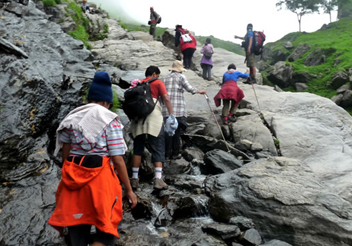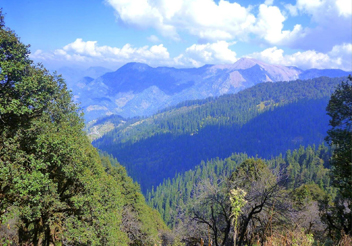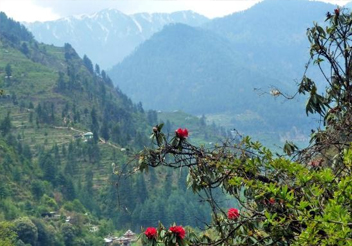Great Himalayan National Park
Trip Fact
The Great Himalayan National Park is the newest addition to India’s national parks lies within the Banjar Sub-division of the Parvati valley of Kulu division in Himachal Pradesh. The park was built in 1984. The park is spread over an area of 1,171 km that lies between an altitude of 1500 to 6000m. The Park is home to more than 375 faunal species. So far species of 31 mammals, 181 birds, 3 reptiles, 9 amphibians, 11 annelids, 17 mollusks and 127 insects belonging to six orders have been identified and documented. Most of the Himalayan fauna has been given protection under the high priority protection category of Schedule I of the Indian Wildlife (Protection) Act, 1972. The state government of Himachal Pradesh has banned hunting in the state for more than ten years. The GHNP also supports a great diversity of plant life thanks to its wide altitude range and relatively undisturbed habitats. From the lofty pinesand spruces and the great, spreading horse chestnuts of the lower valleys, to the dense cushions and prostrate branches of the alpine herbs and junipers, the Park presents an endless variety of vegetation. Although some areas have been modified by grazing, this is one of the few areas of the Western Himalayas where the forests and alpine meadows can be seen in something approaching their original state. The subalpine zone is richest in species, followed by the alpine and upper temperate zones.
A trek of 35 to 45 km in any of the Park’s valleys brings one into the high altitude habitat (3,500 m and above) of animals such as blue sheep, snow leopard, Himalayan brown bear, Himalayan thar, and musk deer. Best sightings can be made in autumn (September–November) as animals start their seasonal migration to lower altitudes. They are protected under strict guidelines of Wildlife Protection Act of 1972, hence any sort of hunting is not permitted. It also supports the variety of plant life, scattered over the park.
An eight-day trek crossing two valleys. Moderate to strenuous. Experience the transitions between two magnificent valleys. This area is Bear country; chances of sighting are very high. Good Probability of Sighting Himalayan Tahr and Musk Deer. This trek is probably the best for spotting wildlife; it takes you through the valleys of Sainj and Tirthan rivers, through a varying range of altitudes and forests, right from dense oak and chestnut to high altitude birch and rhododendron forest.
Outline Day to Day Itinerary:
- Day 01:Arrival Delhi
- Day 02:Arriva Kathgodam & Drive To Loharkhet
- Day 03:Loharkhet – Kharkiya ( 5 HRS BY JEEP ) & TREK TO KHATI (5 kms, 2 hrs)
- Day 04:Khati – Dwali (2575 M/8498 FT)
- Day 05:Dwali – Phurkta (14300 FT) TO PINDARI CAMP SITE 3660 MTS (12,000 feet).
- Day 06:PINDARI GLACIER CAMP – DWALI
- Day 07:Bagubassa – Roopkund (4450 mts/14600 ft) – Bedni Bugyal (7-8 hrs)
- Day 08:Bedni Bugyal – Wan (10 km/ 3-4 hrs) – Rudraprayag
- Day 09:Rudraprayag – Haridwar – Delhi
- Day 10:Delhi – Departure
Detail Itinerary
- Day 01:Arrive DelhiOn arrival you will meet with our office representative, who will escort you to your hotel for the overnight stay. In the afternoon free for sightseeing of Delhi, which includes the grandeur of Old and New Delhi through its heritage monuments, age old bazaars and the new establishments in the capital of India.
- Day 02:Delhi to Bhuntar Airport – to Neuli (1500 M) at GHNPPick up from Bhuntar Air port and further three hours drive to Neuli (1500m) . Remaining day for local sightseeing and overnight in a Guest House.
- Day 03:Neuli to Shakti Trek (2100 M):We start our first days walking experience in Great Himalayan National park after breakfast by moving towards Shakti. The total distance of this day is about 22 Kms and we have a very moderate ascent this day. We walk at lower meadow bridge in Humkhani forest. This forest is home to the endangered king of the birds “the Western Tragopan. Through the beautiful wild surroundings, we reach Shakti and camp for the night.
- Day 04:Shakti to Dhel (3737 M):This is the day to encounter dense forests of the national park which surely gives the opportunity to see the best flora and spot the beautiful birds in the morning hours. The distance of this day is about 11 Kms and the ascents at some places are very heavy. The walnut trees and several herbs make the trek very impressive. A knowledgeable guide of botany make the day extremely informative as various herbs do have finest medicinal values. We reach our Shakti campsite late in the afternoon and relax for the night.
- Day 05:Day hike to Jogni and back to Dehl campThis morning you have high chances to spot Himalayan Thars and Red Foxes particularly and other wild life in general. We take a rest day at Dehl today and move up to Jogni with pack lunch. The walk is easy but with fabulous surroundings. Jognis are very important mythological creatures in Himalaya with Hindu way of followers; these are the deities with open temples. We spend some time at Jogni to have a magnificent view of the peaks of the GHNP and come back to Dehl, the sunrise and sunsets are extremely beautiful at this place. The total distance covered today is about 5 Kms. Overnight at camp.
- Day 06:Dehl to Guntrao (3500 M)This is again a challenging trekking day when we reach to the altitude of about 4100 Meters while trekking towards Guntrao. The climb to the top from base takes about two hours through very narrow path and after the top, we need to walk down with sheer drops of about 200 careful meters. There are nice opportunities to spot Himalayan Thar this day. It is the longest day of the route where we cover about 15 Kms trail with several ups and downs in beautiful park region.
- Day 07:Guntrao to Shilt (3100 M)This is again a different day when we cross through Bamboo forests which are rare in Great Himalayan and Pir Panjal Ranges. Trekking in between of lush bamboo forests make the day colorful and on the way we cross beautiful streams and waterfalls. The total distance with moderate ups and downs is about 16 Kms and takes about 6 hours of comfortable walk. In the evening we reach to our campsite at Shilt for the overnight stay.
- Day 08:Shilt to GushainiThis is the day with almost steep descents through dense forests to Gushaini covering a distance of about 15 Kms. Gushaini is a small town surrounded by the mighty snow crowned Himalayan peaks. It is located in the deep Tirthan valley amidst the orchards on the slope of the mountains. Gushaini is remarkable for her beautiful landscape, the stunning view of the Himalayan peaks and the calm and serene environment. It is also known as a ‘Trout Country’ as it is famous in trout fishing. We spend the night at a nice home stay and enjoy the hospitality.
- Day 09:JGushaini to Shoja drive and walk to Sarolsar Lake through Jalori PassThe drive to Shoja from our home stay is about 22 Kms through Banjar and Jibhi. The drive is simply pleasing. This tiny hamlet is located at a height of 8000 feet with the dense forests, small waterfalls and the lush green landscape which make it truly breathtaking. Shoja gives you a spectacular view of the Jalori Pass and the Himalayan peaks. We check into our camp at Shoja and drive to Jalori Pass for another half an hour’s time.
From Jalori Pass you have to walk 6km to reach Sarolsar Lake through forests lined with oak, blue pine, spruce fir and deodar trees. It is a small lake and the locals consider it as a very holy place. After visiting this beautiful and clean lake, we walk to Jalori and drive 5 Kms down to Shoja for overnight stay. - Day 10:Shoja to Shimla drive, 153 Kms/ 6 hoursMorning drive down to Sutlej valley and join the national highway close to Rampur after crossing a bridge on River Sutlej. Shimla is about 120 Kms from here and the roads are very nice to cover this distance in 3-4 hours. We can stop for tea at Narkanda on the way which is the entry point of old Hindustan Tibet road. On arrival, check in to your hotel in Shimla and evening is free to stroll on mall Road.
- Day 11:Shimla sightseeing and drive to Chandigarh in the eveningFull day sightseeing of Shimla includes visits to the historic buildings like Vice Regal Lodge, Gaiety Theatre, Scandal Point, Railway board Buildings, Gorton castle and Jhaku Temple dedicated to Lord Hanuman at the top of Jakhu Hills. We leave Shimla and drive 110 Kms to Chandigarh- the most organised and planned city of India designed by French Architect Le Corbusier. Evening is free to explore this beautiful city.
- Day 12:Chandigarh to Delhi Train and fly back homeMorning we take the Shatawdi train, a fastest and comfortable train to Delhi which takes only 3 hours to cover this distance. On arrival, you will meet our representative, although your GHNP guide will be with you, and drive to your hotel. Rest of the day is free in Delhi and later we drive you to the international airport for your flight back home.



